GEEKOM A7 mini-PC Review : Premium Phoenix in a Compact 4x4 Package
by Ganesh T S on May 31, 2024 8:00 AM ESTSystem Performance: UL and BAPCo Benchmarks
Our 2022 Q4 update to the test suite for Windows 11-based systems carries over some of the standard benchmarks we have been using over the last several years. While UL's PCMark makes the list, we have opted to temporarily suspend reporting of BAPCo's SYSmark scores (pending fixture of the energy consumption aspect). Instead, BAPCO's CrossMark multi-platform benchmarking tool has been added to the set along with UL's Procyon suite. While CrossMark employs idle time compression and processes all workloads in an opaque manner, UL's Procyon processes real-world workloads with user interactions (like BAPCo's SYSmark). We have augmented the UL Procyon suite benchmark with our own custom energy measurement setup.
UL PCMark 10
UL's PCMark 10 evaluates computing systems for various usage scenarios (generic / essential tasks such as web browsing and starting up applications, productivity tasks such as editing spreadsheets and documents, gaming, and digital content creation). We benchmarked select PCs with the PCMark 10 Extended profile and recorded the scores for various scenarios. These scores are heavily influenced by the CPU and GPU in the system, though the RAM and storage device also play a part. The power plan was set to Balanced for all the PCs while processing the PCMark 10 benchmark. The scores for each contributing component / use-case environment are also graphed below.
| UL PCMark 10 - Performance Scores | |||
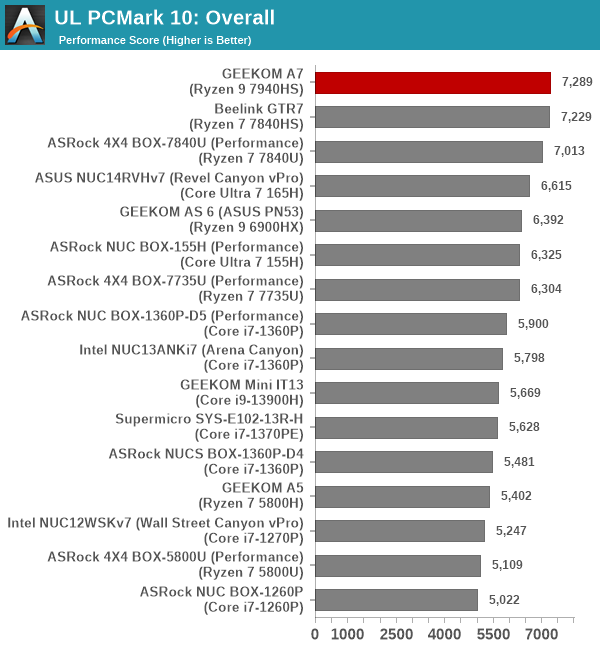
The Ryzen 9 7940HS has higher boost clocks for both the CPU and iGPU than the other processors in the compared list. So, for real-world consumer use-case workloads, the thermal limitations do not enter into the equation. That said, some multi-core workloads may benefit from higher power budgets. So, 65W configurations of processors such as the Ryzen 7 7840HS may surpass the Ryzen 9 7940HS with a lower power budget in specific segments. Overall, we see the GEEKOM A7 at the top of the chartes with a slender lead over the 65W configurations of Meteor Lake-H (ASUS Revel Canyon NUC) and Phoenix Ryzen 7 7840HS (Beelink GTR7).
UL Procyon v2.1.544
PCMark 10 utilizes open-source software such as Libre Office and GIMP to evaluate system performance. However, many of their professional benchmark customers have been requesting evaluation with commonly-used commercial software such as Microsoft Office and Adobe applications. In order to serve their needs, UL introduced the Procyon benchmark in late 2020. There are five benchmark categories currently - Office Productivity, AI Inference, Battery Life, Photo Editing, and Video Editing. AI Inference benchmarks are available only for Android devices, while the battery life benchmark is applicable to Windows devices such as notebooks and tablets. We presents results from our processing of the other three benchmarks.
| UL Procyon - Office Productivity Scores | |||
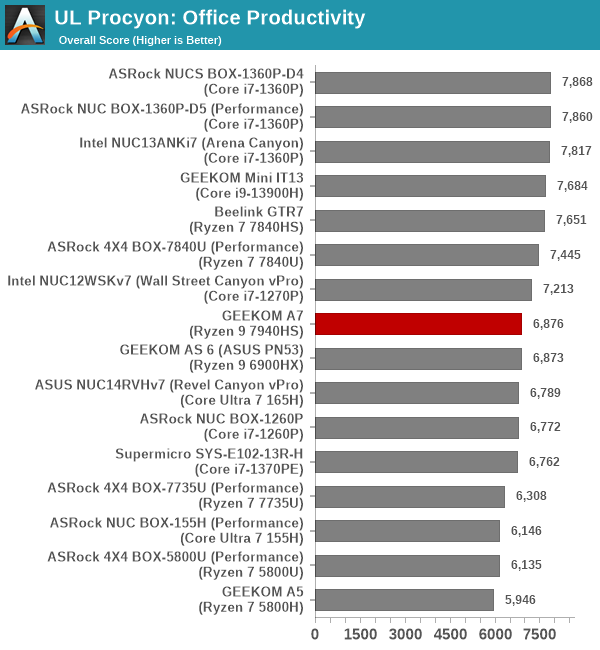
The UL Procyon offie workloads benefit immensely from a higher power budget. We see the 65W configurations making a separate set at the top, with the GEEKOM A7's 35W configuration relegated to the middle of the pack.
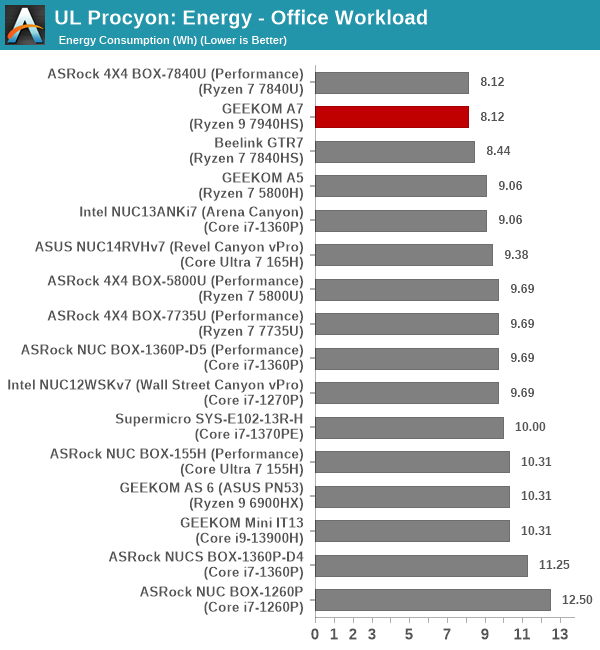
From an energy consumption viewpoint, the AMD Phoenix systems round out the top 3 with a healthy lead over the Arena Canyon NUC (that happens to be hte most energy efficient of the lot among Intel-based systems). The generational improvements over Cezanne are also evident in the above graph.
Moving on to the evaluation of Adobe Photoshop and Adobe Lightroom, we find the A7 leading the pack by a significant margin. The fast and powerful integrated GPU makes a bit of a contribution here to help the A7 extend its lead over other systems.
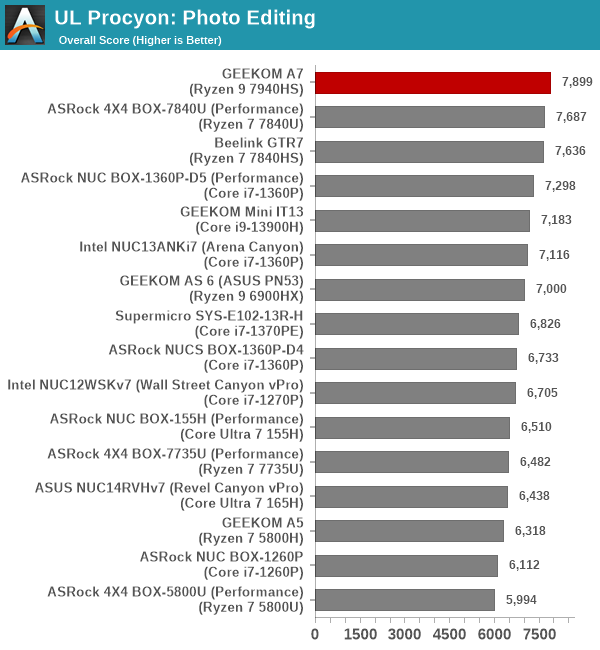
Both the GEEKOM A7 in a 35W configuration and the ASRock Industrial 4X4 BOX-7735U in a 28W configuration gets the job done with minimum energy consumption, with a healthy lead over the GTR7 in this aspect. The Intel-based systems are all further down in this energy efficiency comparison.
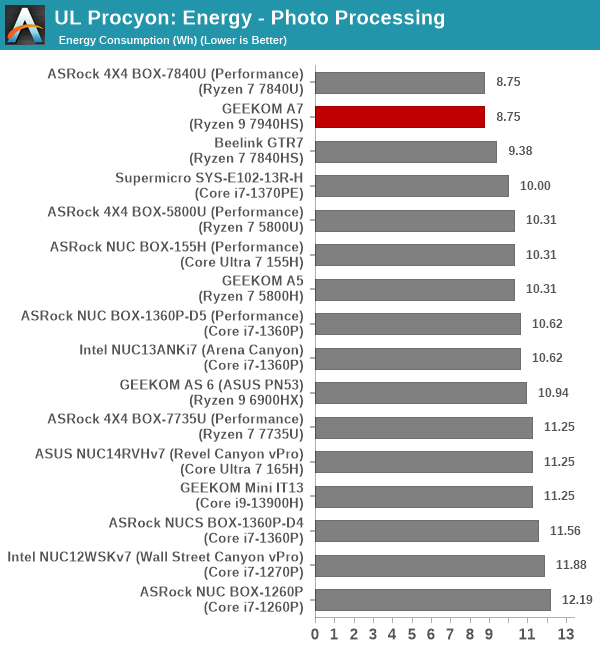
UL Procyon evaluates performance for video editing using Adobe Premier Pro.
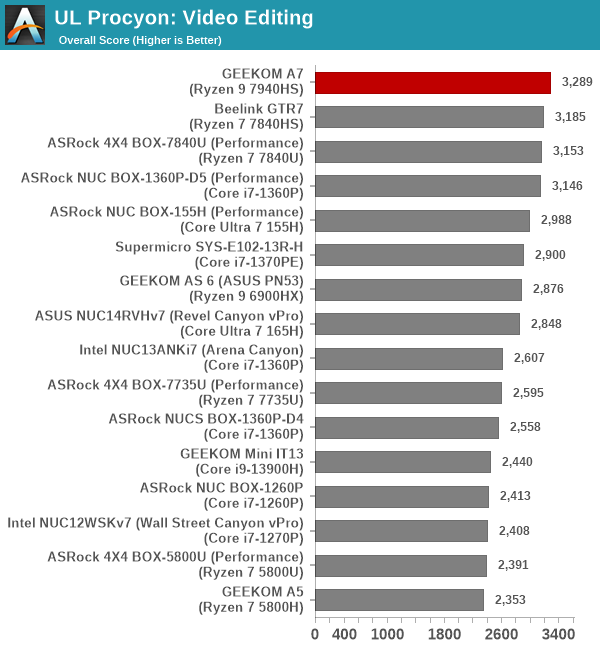
The A7 continues to cement its position at the top in this workload. The results mirror the ones obtained for the photo workload for the same reasons.

The GEEKOM A7 gets the job done faster than all other contenders, but narrowly misses out on the energy efficiency crown. Only the Raptor Lake-P-based Supermicro 3.5" SBC system managed to get the job completed with lower energy numbers.
BAPCo CrossMark 1.0.1.86
BAPCo's CrossMark aims to simplify benchmark processing while still delivering scores that roughly tally with SYSmark. The main advantage is the cross-platform nature of the tool - allowing it to be run on smartphones and tablets as well.
| BAPCo CrossMark 1.0.1.86 - Sub-Category Scores | |||
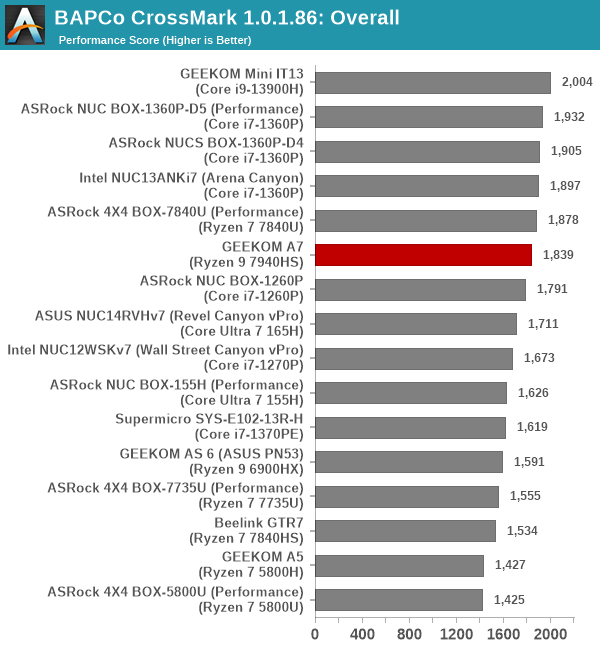
The A7's Ryzen SoC is configured for a 60W / 42W / 35W operation mode (similar to the PL1 / PL2 of the Intel systems). Since CrossMark workloads involve idle time compression, the short bursts of higher power help the A7 move towards the middle of the pack in the productivity and responsiveness workloads, and the iGPU prowess lands it at the top in the Creativity workload. However, idle time compression and the PL1 / PL2 boosts in Intel systems act in tandem to give Intel-based systems a better overall score in this benchmark. We believe that idle time compression is not reflective of real-world usage and UL Procyon's real-time replay is a better candidate to determine the effectiveness and efficiency of a particular system. The benchmark is still included to provide a comparison point that could be relevant to specific workloads.










18 Comments
View All Comments
TheinsanegamerN - Friday, May 31, 2024 - link
I feel like I'd be much more excited about these when we get a strix halo version.The Hardcard - Friday, May 31, 2024 - link
The problem is by the time of the review, there will be so many details leaked about Zen 6 products that your excitement for Strix Halo will be crushed.kn00tcn - Friday, May 31, 2024 - link
did you forget what strix halo will be? the single biggest leap in gpu size in any apu ever, it's extremely unlikely that the gen right after that would somehow leap again unless integrated gddr is usedt.s - Saturday, June 1, 2024 - link
bingo!meacupla - Friday, May 31, 2024 - link
The one shortcoming of all these startup mini-PC brands is longer term BIOS support.My 2020 AMD Renoir Dell laptop still gets occasional BIOS updates, but the same cannot be said of the trigkey, kamrui, or bosgame mini-PCs that I have kicking around.
Desierz - Friday, May 31, 2024 - link
Have you considered if they really need BIOS updates?PeachNCream - Friday, May 31, 2024 - link
They generally work with release BIOS versions but its quite common to see updates later resolve problems or enhance relaibility so after sales support can a significant consideration.kn00tcn - Friday, May 31, 2024 - link
have you considered agesa updates have already contained important memory, usb, and security updates multiple times in the past?meacupla - Friday, May 31, 2024 - link
They do. One of them is missing a critical fix for Zen bleed. So it's missing Agesa 1.2.0.bkn00tcn - Friday, May 31, 2024 - link
those sound like random aliexpress 'brands', while geekom or minisforum have been established worldwide names by contrast (not that i've checked their updates, even majors like asrock are disappointing for agesa updates on deskmini/deskmeet)